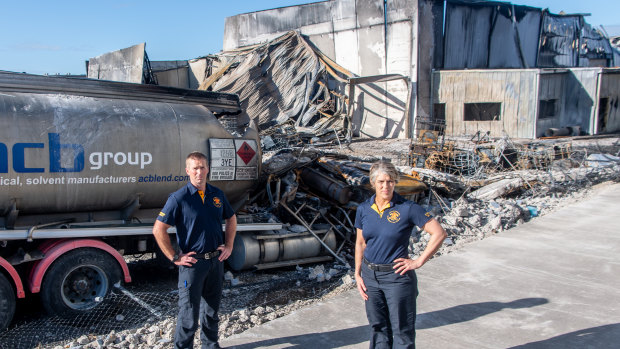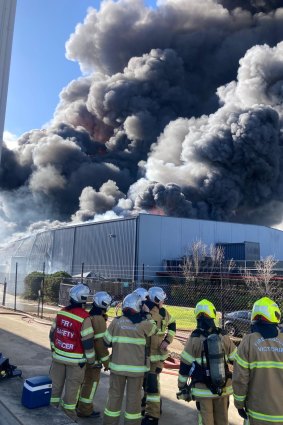Firefighters plagued by equipment failure at Derrimut industrial blaze
A litany of equipment failures and missing gear hampered the battle against the huge industrial blaze in Derrimut, potentially putting the safety of firefighters and the public at risk.
Firefighters and the United Firefighters Union have documented a series of mechanical faults and resourcing problems that they claim allowed the chemical fire to spread faster and grow more dangerous in the early hours of the response.
More than 180 firefighters spent days extinguishing the seventh-alarm-level blaze at ACB Group facility. The plant was storing hundreds of thousands of litres of kerosene, fuel, methylated spirits, ethanol and other dangerous goods that were highly flammable and toxic.
It was the largest industrial fire in Victoria since the 2018 West Footscray blaze, which erupted in an illegal chemical waste dump.
The problems plaguing the response on July 10 included a critical 15-minute delay in the arrival of a key firefighting vehicle, known as a teleboom, which would have been able to attack the blaze from above.

Dion Robinson, who was on the scene at Derrimut, and union health and safety representative Kat Dunell, who attended the 2018 Footscray fireCredit: Justin McManus
The delay was created because the truck had been moved about 40 kilometres away to cover long-running and worsening gaps in the Fire Rescue Victoria fleet.
Another key vehicle, a heavy pumper truck capable of releasing massive volumes of water and foam, broke down twice in the course of fighting the blaze.
The vehicle, which was nearly 20 years old, was deployed that day at Derrimut as an emergency back-up to replace a newer appliance that had been taken out of service for maintenance.

The industrial fire at ACB Group
A source in Fire Rescue Victoria, who has direct knowledge of the incident but can’t speak on the record about operational matters, said the breakdowns and lack of fit-for-purpose gear thwarted the ability of firefighters to attack the blaze and exposed them, local businesses and the public to unnecessary danger.
“Every second, every minute is too long,” the source said. “You have to have trucks on the ground getting copious amounts of water and foam onto an incident like that as quickly as you possibly can.”
The teleboom that normally would have responded from nearby Sunshine had been redeployed to Ringwood after the same type of appliance covering that area of the city broke down. The closest teleboom that could be called in came from Richmond station.
“That teleboom would have been the first aerial that should have been put in place, and to try and stop it spreading with the ferocity it spread,” the source said.
The dire need to respond to the Derrimut blaze also meant a key truck – known as an ultra-large pumper, one of only two in the state – that was in FRV’s Thornbury workshop had to be immediately repaired and sent to Derrimut.
There were a number of other problems with equipment reported that day, including some issues that potentially threatened to increase the exposure of firefighters to the toxic chemicals.
“You’re constantly in and around all the fumes,” said firefighter Dion Robinson, who arrived shortly before noon and remained on the scene until 8pm. “If you want to shelter in the truck, you can’t sit in the truck because the air-conditioners are broken. Our cabins on the trucks overheat.”
After the fire, Robinson reported symptoms of suspected chemical exposure that included a sore throat, fatigue and nosebleeds.
“[The equipment breakdown is] frustrating and it endangers your whole plan,” Robinson said. “You have to go to plan B, plan C to ensure you carry out the firefight properly and effectively.”
The UFU has repeatedly warned that FRV’s fleet of more than 200 vehicles is experiencing regular and worsening breakdowns due to the age of the equipment.
The UFU claims that 40 per cent of the vehicles called to the Derrimut fire – which make up about a quarter of Fire Rescue Victoria’s entire fleet in the state – are past their 15-year lifespan. The union estimates that nearly two-thirds of vehicles will be past their use-by date within a year.
“We don’t have a spare fleet any more,” the FRV source said. “We could go into this weekend and if there is a breakdown, there might be one or two spare trucks across the whole state. And trucks go down all the time.”
A Fire Rescue Victoria spokesperson said the “safety of our firefighters, other first responders and the community is paramount”.
“Given the volatile nature of the incident, a decision was made not to put firefighters too close to the fire,” the spokesperson said. “This included not using aerial appliances.
“At all times, FRV ensures that appropriate equipment is deployed to emergencies to protect firefighters and the community. There is no single point of dependency.”
Whether the Fire Rescue Victoria fleet is ageing beyond its safe and effective use-by date has become a source of contention between the state government and FRV and UFU.
It has been a long-standing FRV – and before it, the then-Metropolitan Fire Brigade – policy that the maximum lifespan for a firefighting “appliance” is 15 years, according to FRV documents.
Emergency Minister Jaclyn Symes has publicly challenged the claim the fleet is in a poor state, saying during a press conference in Mildura this week that it was irresponsible to have a “cut-off period for a truck that’s been looked after and hasn’t responded to a lot of fires”.
“I would just take issue with the statement that implies that a truck of 15 years old should be decommissioned,” she said. “Just because a truck has a birthdate doesn’t mean it’s not fit for purpose.”
A “rolling replacement” program for firefighting vehicles was abandoned in 2013 under the then Liberal government and has never been restarted.
A government spokesperson said Fire Rescue Victoria’s vehicles and equipment were “maintained by an expert team to ensure they are both safe to use and ready to respond”.
“We have delivered more than $100 million to ensure our firefighters have the trucks, resources and equipment they need to protect Victorians and keep themselves safe.”
Get the day’s breaking news, entertainment ideas and a long read to enjoy. Sign up to receive our Evening Edition newsletter here.